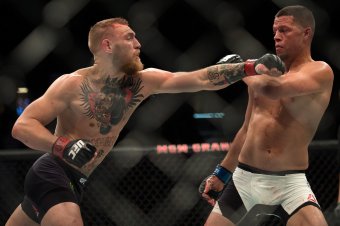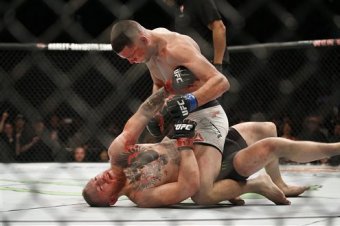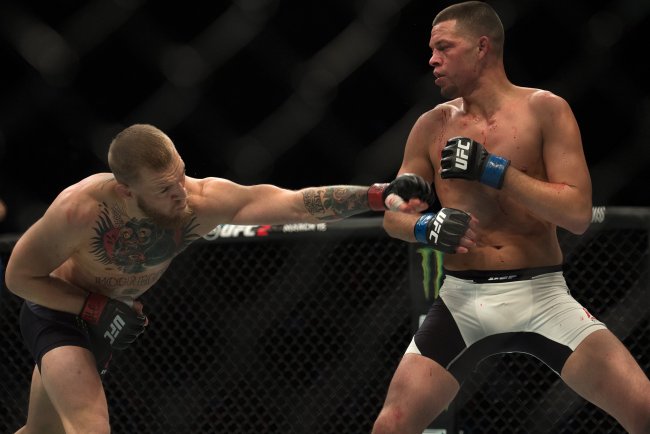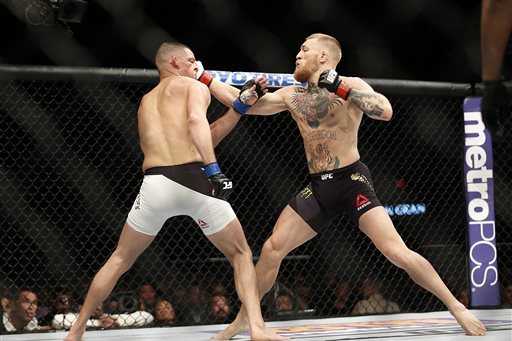Nate Diaz's win over Conor McGregor at UFC 196 in March was a stunning upset.
The verbose McGregor hadn't lost in more than five years. He had won all seven of his UFC bouts, six of them by knockout, in a streak that concluded with a 13-second icing of longtime featherweight kingpin Jose Aldo.
The next step in McGregor's inevitable rise to international superstardom was a bout with lightweight champion Rafael dos Anjos. Two weeks before the fight, however, Dos Anjos was forced to withdraw with a nasty foot injury.
Into the breach stepped the veteran and fan favorite Nate Diaz, who had called out McGregor in an epic, profanity-laced (link contains NSFW language) post-fight speech following his win over Michael Johnson the previous December.
Contrary to reports that he had been training for a triathlon at the time he accepted the fight, Diaz had actually been on a boat in Cabo San Lucas, Mexico, drinking tequila.
None of that mattered. In one of the best fights of the year, Diaz withstood McGregor's left hands, hurt the Irishman with punches and then jumped onto a choke when McGregor shot an exhausted and rocked takedown in the second round.
McGregor's winning streak was over, and Diaz wasn't surprised (warning: NSFW language).
The two men were scheduled to meet again in the main event of UFC 200, but McGregor's refusal to do media and then brief retirement led to a rescheduling for UFC 202 on Aug. 20.
So that's how we got here. In this piece, we'll go over each fighter's game before breaking down their first meeting, and we'll conclude by offering up a preview and prediction of the rematch.
Conor McGregor
Record: 19-3 (17 KO, 1 SUB, 1 DEC)
Height: 5'9"
Reach: 74"
McGregor is a southpaw puncher. He tore through the featherweight division on his way to meeting Jose Aldo, going the distance only once, against the ultra-talented Max Holloway in a fight in which McGregor blew out his knee. Wrestler Chad Mendes gave McGregor some real trouble, but the Irishman overcame a few rough spots for the second-round knockout.
Power is McGregor's calling card. His left hand is a thing of snapping, destructive beauty whether he delivers it as an overhand, an uppercut or, most often, a straight. The right hand serves mostly as a means of probing and measuring the distance, though he likes the lead-hand uppercut and works in lovely right hooks to the body when he flurries.
McGregor's game is designed to beat smaller orthodox fighters. He uses his array of front, spinning, side, oblique and round kicks to keep opponents on the end of his long reach, and the orthodox-southpaw pairing adds another few inches of distance.
With his opponents stuck on the outside, McGregor can fire off crisp, efficient left hands to his heart's content while beating up the body and legs. If his opponent tries to leap in, McGregor can crack him with a sharp left-hand counter from the inside angle like those he used to finish Aldo or Ivan Buchinger in Cage Warriors years ago.
Pressure and pace have been key to this approach. McGregor loves to back his opponent to the fence and unload flurries, and the combination of footwork and arcing kicks cuts off escape angles as he moves forward. If he's the one dictating the range, McGregor can work fast because he doesn't have to explode to cover distance. This allows him to be smooth and efficient with his energy.
Defense isn't McGregor's strong suit. He knows how to move his head to avoid punches, but connecting that head movement to offense in the pocket doesn't come as naturally to him.

The Irishman tends to be open after throwing the left hand, not so much because he overextends but because he has a bad habit of bringing it back to his chest or stomach instead of his chin. This is a serious problem against dangerous counterpunchers.
While striking is McGregor's wheelhouse, he's far from a novice elsewhere.
McGregor's takedown defense came in for some criticism after the win over Mendes, though McGregor's coach, John Kavanagh, told Ariel Helwani on The MMA Hour (via Marc Raimondi of MMA Fighting) that the Irishman had done "no live wrestling" for that camp due to a knee injury. Prior to that, it hadn't been much of an issue.
Offensively, McGregor has a nice double-overhooks throw in the clinch and can hit beautiful reactive takedowns as his opponent comes forward. He drives through and finishes with authority against even accomplished defensive wrestlers.
As with his wrestling following the Mendes fight, McGregor's grappling skills have come into question after the submission loss to Diaz. All three of McGregor's losses have come by tapout, but that doesn't mean he's unskilled on the mat, and the problems with his ground game have been vastly overstated.
On top, McGregor has a slick pressure-passing game he integrates with hard ground strikes. He maintains control well and keeps a heavy base, consistently looking to get to dominant positions. Cage positioning is a fundamental part of McGregor's top game. He's much more likely to grapple for extended periods of time against the fence, where he can pin his opponent's hips in place and land shots at will.
Scrambles have been where McGregor has struggled, as he did against Diaz when his poor takedown turned into a sweep. He isn't much of a guard player, either, and relies on stuffing his opponent's shots rather than fighting from his back.
Is he one of the best UFC grapplers? No, not by any measure, but he's also a long way from being a novice.
Nate Diaz
Record: 19-10 (4 KO, 12 SUB, 3 DEC)
Height: 6'0"
Reach: 76"
Diaz is a southpaw boxer by trade. Boxing isn't just punching, and Diaz is a master of the subtleties of his craft: footwork, timing, distance, rhythm and above all efficiency.
The jab is the foundation for everything Diaz does in the cage. He probes with his lead hand, tapping away to set the distance and rhythm that everything else in his game plays off at an extremely quick pace.
If his opponent is content to accept that range, Diaz laces him over and over with crisp jab-cross combinations and throws in the right hook for good measure from time to time. If the opponent tries to pressure, Diaz loops a counter right hook around the guard as he pivots out to take a new angle and avoid the forward movement. Once he resets the range, Diaz goes right back to work with the jab.
Pivots and bits of subtle footwork are the key to this kind of game. There are no big, leaping movements, just the barely noticeable small steps, turns and angles that flow under the surface beneath Diaz's constant stream of punches.
Those small steps and pivots combine with the long punches to set a distance that's difficult for opponents to cover. Since Diaz isn't stationary, that range is dynamic and adjusts to the opponent's movement, all with a minimum of expended energy.
Diaz carries surprising power in his shots, even if they look effortless. "I came in as he threw one of his crosses, where he was completely sitting down on it and solid. It was the hardest I've ever been hit in a fight," former opponent Jim Miller told MMA Fighting's Shaun al-Shatti.

It's possible to look at Diaz and conclude he gets hit too much, and it's true the Stockton, California, native won't be confused for Jose Aldo or Anderson Silva anytime soon. But it's a mistake to overstate how hittable Diaz is, and in so doing to miss some of the craft that makes him such a maddening fighter to face.
When Diaz stands in front of his opponent throwing shot after shot, he looks easy to hit, but his length baits opponents into wasting their energy throwing big haymakers at his head. By sticking his head out, Diaz can draw out his opponent's strikes while leaving room to pull his head back, which either avoids the shot entirely or takes most of the sting off it.
Even if it's not that difficult to land on Diaz, it's shockingly hard to hit him with a shot that really counts.
Pace is everything for Diaz. Few fighters, if indeed there are any, can match his volume and offensive output. He throws more as the fight goes on, picking up the pace until he buries his opponent under a wave of snapping punches.
In the clinch, Diaz is deceptively strong. His long limbs give him surprising leverage, which he uses to create space for hard knees, short punches and a variety of trips and throws. Defensive wrestling isn't his strongest suit, though, and accomplished takedown artists have succeeded in putting him down with regularity.
Diaz is generally fine with that outcome. He's a phenomenal guard player with an active, attacking bottom game that focuses on triangle-armbar-sweep chains executed at great speed and with smooth technical skill.
The Stockton native is no picnic in transitions, either, and has a nasty series of guillotine and other front- headlock chokes he combines with sweeps against opponents who shoot for lazy takedowns.

On top, Diaz is beyond nasty. His long limbs and great posture make him a fearsome ground striker, and his passing game is as slick as one would expect from a high-level black belt. His pressure is suffocating, and he excels at forcing opponents to give their back.
The First Fight
In the opening round of their matchup at UFC 196, McGregor came out hot, probing behind a succession of oblique and side kicks to Diaz's lead leg. He had some success leaping in with a feinting lead hand and then dropping a hard left behind it. Some of those left hands landed cleanly, including the shot that opened Diaz's eyebrow, but the American rolled with or deflected many more.
It was McGregor's round, but in winning the battle he helped himself lose the war. In leaping in with those left hands, McGregor burnt a great deal of energy; he had almost no success landing the more efficient counter lefts that have been his bread and butter throughout his career. Diaz's jab kept him outside, and while McGregor was able to cover the distance, that process cost him valuable gas.

The first three minutes of the second round were the culmination of this process. McGregor pressed the action even more, which cost a great deal of energy even as he thought he was hurting Diaz badly.
He wasn't. It was Diaz who stung McGregor at the 2:20 mark of the second round, and that was a McGregor who was clearly tired already.
The combination of being hurt by Diaz's punches and tired from a pace that suited Diaz more than McGregor was bad enough, but McGregor doubled down by allowing himself to get into a firefight. When Diaz poured it on, McGregor shot for a bad takedown, ended up on the bottom and gave up the fight-ending rear-naked choke shortly thereafter.
Diaz did a fantastic job of using his jab to keep McGregor at range while constantly moving his feet to stay off the fence. McGregor was never able to pin him against the cage, where the Irishman has been able to land shots at a high volume without expending his energy. In open space, Diaz forced McGregor to explode forward time after time, and that's an energy-intensive process.
McGregor compounded Diaz's control of the distance by consenting to fight at the American's pace. Getting sucked into a high-volume firefight with Nate Diaz is a losing proposition.
Diaz is an elite grappler, and he owns a substantial edge in skill and experience on the mat. The combination of that lethal skill with McGregor's exhaustion and the aftermath of being rocked by punches did the Irishman in.
Betting Odds
McGregor -125, Diaz +105 (via Odds Shark)
Prediction
The basic outlines of this fight make it a difficult matchup for McGregor. Diaz is a longer southpaw with better pure boxing footwork and a more active lead hand who has the chin to eat McGregor's punches while working at a pace the featherweight champion will struggle to match.
That lead hand is key. Diaz used it to control the distance with his jab and catch McGregor coming in with right hooks, while McGregor's reliance on the left hand and the openings he leaves after throwing it created opportunities for Diaz to land a steady stream of counters. If McGregor doesn't give Diaz something to worry about with his own jab and a more effective right hook, he can't hope to compete at boxing range.
McGregor's kicks can help to make up that gap, but only if he sticks with them. He needs to tap away with the side, oblique and round kicks to Diaz's lead leg, land round and front kicks at Diaz's jabbing range and lay off the high-energy spinning kicks.
The Irishman needs to do all that while avoiding the temptation to engage Diaz in a slobberknocking brawl. He can't get drawn into Diaz's pace, his rhythm or his preferred range, and he can't simply stand in front of the American and hope to counter every shot with the left hand.
Especially against the fence, McGregor can look for takedowns and some brief periods of top control. He should avoid shooting in open space, though, where Diaz can let his hips move freely in the guard.
It's entirely possible a disciplined, prepared McGregor can pull that off.
It's a tall order, though, while Diaz's path to victory is much simpler: keep moving, stay off the fence and stick the jab in McGregor's face over and over and over again. That should wear the featherweight champion down and create opportunities for a late finish.
Many more things have to go right for McGregor's game plan to work than Diaz's, or McGregor has to land a knockout shot against one of MMA's most durable fighters. That's less likely than Diaz pumping the jab against a shorter fighter and sucking the fiery McGregor into a brawl.
For that reason, the pick is Diaz by decision or late finish.
Patrick Wyman is the Senior MMA Analyst for Bleacher Report and the co-host of the Heavy Hands Podcast, your source for the finer points of face-punching. He can be found on Twitter and Facebook.




















